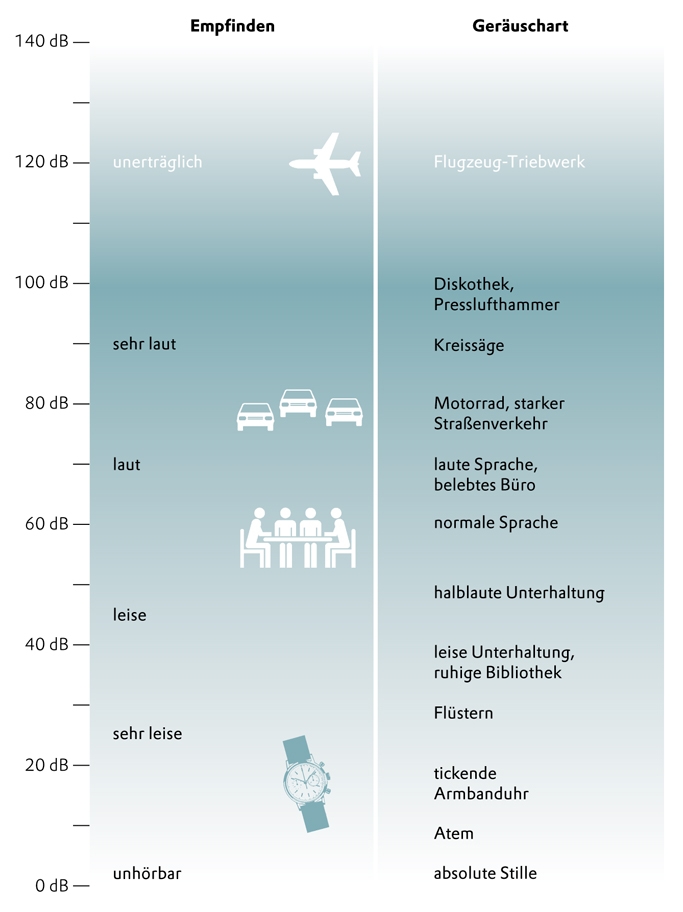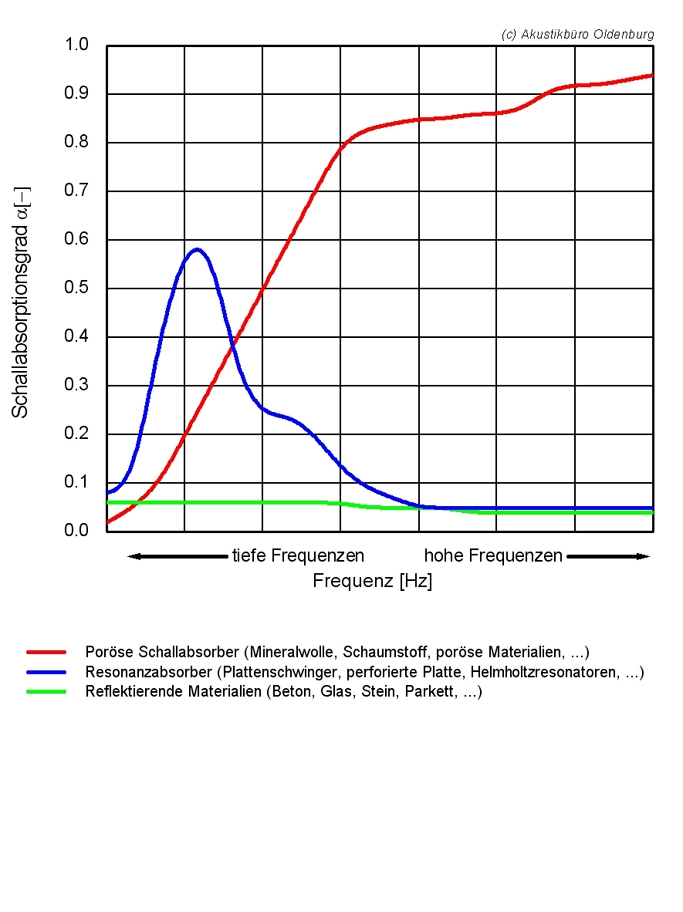
Find out more
Room acoustics – Introduction
Guest author: Dr. Christian Nocke, Akustikbüro Oldenburg
Design as planned
When it comes to the term “interior design” we usually think of optical circumstances in a room: colours, shapes and surfaces of the floor, the walls and the sealing. And of course of the furnishing, which attributes significantly to the character of a room.
That rooms are not only spotted with our eyes but also with our ears is usually not recognized until we are disturbed by inadequate acoustical circumstances, e.g. a high sound level or a bad speech intelligibility. In most cases then the question arises: 'Could we have done it any better?' In nearly every case the answer to that question will be an unlimited 'Yes', because room acoustics is usually characterized by a strong project plan and therefore it is predictable. It is also known, under which circumstances people do recognize a room as comfortable or feel disturbed by it.
Basically every room can be designed in an acoustical optimal manner. By the aid of modern computer software it is possible, to pre-calculate the acoustics of a room in detail. In particular for rooms with a high demand of acoustical requirements, such a planning is always suggested.
The aim is always to create a room, in which we feel comfortable, where we can communicate without constraints and where we recognize noises as not too loud nor as too low.
Architectural Acoustics and Room Acoustics
Basically the sections 'Architectural Acoustics' and 'Room Acoustics' deal with two completely different attributes of a building.
Regarding the architectural acoustic, the requirements are geared to the level of noise, which is transferred from one room to another. In practice, this usually affects rooms, which are next to each other or located on top of each other. If the implemented assemblies (walls, sealing, doors, windows) are not dimensioned correctly or not have been constructed professionally, this can lead to interferences of a building. Then e.g. claims will arise, that conversations in adjoining rooms can be traced or noises from other rooms do invade too much in the own territory. Requirements to architectural acoustics are introduced on the one hand by the German standard DIN 4109 “Sound insulation in buildings; requirements and testing” and on the other hand generally owed to the building owner; even if there is no concrete agreement.
By contrast, there is a lot of literature available regarding the planning and design of room acoustics – e.g. standard DIN 18041 “Acoustical quality in small and medium–sized rooms” or VDI 2569 "Sound protection and acoustical design in offices" – though its content just has an advising intention in general. A constructional entitlement to an appropriate room acoustic does not exist and should therefore always be part of contractual agreements.
The room acoustic is always examine one room itself: one office, one call centre or meeting room, also one class room, an indoor swimming pool or a concert hall. The object of observation in general, are the acoustic conditions in the room itself, which are mainly created by the surfaces and furnishing used.
The sound
Sound events as noises, speech or music are noticed accordingly to their sound pressure level. Our acoustic perception starts at about 20 dB (ticking clock); a whispering conversation is about 30 dB.
The significant variable to describe the noise exposure of a workplace is the so called criterion level Lr, which results of the measured equivalent continuous noise level and additional or reduced values depending on the characteristics of the noises as well as its duration of influence. Empirical value shows, that intellectual activity is restrained from a criterion level of 55 dB on. Noise levels within an office should therefore be lower than this value to allow for appropriate working circumstances for all employees. In a normal conversation, we are exposed to an acoustic pressure level of 60 dB. From a criterion level starting at 80 dB, guidelines for the protection of the sense of hearing become valid and beyond the 100 dB, irreversible damages of our hearing should be feared, even if the time of influence is short. Such noise levels appear usually close to jackhammers or aircraft jets, but sometimes also in discotheques and rock concerts. (See fig. 1)
What we sense
Next to the acoustic pressure level, the frequency configuration and respectively the acoustic spectrum are of particular importance. The human sense of hearing usually recognizes frequencies between around 20 Hz and 20.000 Hz. Music covers this spectrum almost completely, whereas speech is usually limited to frequencies between 250 Hz and 2000 Hz. Here the human sense of hearing is extremely sensitive.
Because our hearing is differently sensitive at varying frequencies, one consequence is that room acoustical values as reverberation time, acoustic pressure level or the acoustic absorption level of a material are, as a basic principle, stated as subject to a frequency.
Also in the literature of technical rules and standards, the specific sense of human hearing does attract interest. In the range of architectural acoustics, which deals with sound propagations between rooms, the frequency-range between 100 Hz and 3150 Hz is considered. Room acoustical recommendations and suggestions mostly refer to the frequency-range from 100 Hz until 5000 Hz.
How a room ‘sounds’
How a room 'sounds', is usually conditioned by the reverberation time of the room. Simply stated, the reverberation time is the time period needed for a sound event to become inaudible within a room. When measuring the reverberation time, usually a frequency-range of 100 to 5000 Hz is covered. The longest reverberation times of 5 seconds and more are usually noticed in churches, the shortest reverberation times of 0.3 seconds and less in sound studios or wiretap cabins. Depending on size and use of the room, the optimal reverberation time is somewhere in between.
In bigger rooms, our perception usually anticipates longer reverberation times than in smaller rooms. If room size, use and reverberation time do not match each other, the user will be bothered and claims will arise. Is the reverberation time too long, the room is described as noisy and booming. Is it too short, the room will be described as uninspiring and dull.
DIN 18041 does allow for these special circumstances of the human sense of hearing by stating an increasing target-reverberation time for every room type with an increasing room volume.
The reverberation time
The standard DIN 18041 suggests recommendations towards the reverberation time, which is geared to the size and use of a room.
Generally the shortest reverberation times are required for 'tuition and communication'. Less absorption and therefore a too long reverberation reduces the speech intelligibility, which necessarily will be counterbalanced by an increased speech volume. For speeches or musical activities, longer reverberation times are suggested. (See fig. 2)
Example: A meeting room of 250m2 should have a reverberation time of 0.6 seconds.
Measuring supplies clarity
Measuring the reverberation time can help to detect potential deficiencies and therefore establish a basis for improvement suggestions. Using the results of measurement, detailed suggestions towards specific materials and needed dimensions to create an ideal room acoustic can be given. Costs which arise during the measurement are usually reduced by exact dimensions of the square footage, which means that unnecessarily installed equipment will be saved and more safety is gained, that an action will lead to the desired achievement.
Sound absorber
Even there are a lot of sound absorbing materials; these can be traced back to two physical mechanisms: porous and vibratory sound absorber.
Regarding the porous absorber, e.g. mineral fibrous insulating materials or foam insulations, the sound impinges onto the absorber. The energy of the sound will be transformed into heat energy within the pores of the material. Thereby the reflected sound of the material will be minimized.
Vibratory sound absorber, also called resonance absorber, will be animated to oscillate by the impinging sound, e.g. a swinging wood or metal panel. The oscillation energy will be transformed into heat energy by friction.
Porous absorbers are efficient at a usual panel thickness (10 to 20 cm) with medium and high frequencies. Resonance absorbers are usually attuned to low frequencies.
Furthermore there are hybrid forms, which imply both physical mechanisms. These often have the advantage, to allow for a wide spectrum of sound absorption.
Sound absorption
The acoustic virtue of a material (or object) is specified by the sound absorption level. This level can be between the value 0 (no absorption, e.g. a concrete wall) and 1 (full absorption, e.g. wall surfaces in a record studio). The sound absorption level is highly dependent on the frequency and should therefore not only be described by a single value but rather by a set of values, depending on the frequency.
Under the specifications of standard DIN EN ISO 354 [12], the sound absorption level is measured between a frequency range of 100 Hz to 5000 Hz and constituted by αs. For every frequency α100, α125, α160, ... , α4000, α5000 you then get a value towards the sound absorption, which do add up to the curves, which are shown in figure 3. Each sound absorber however, features its own fingerprint through its unique absorption curve.
Absorption in a room
How much sound absorption is in a room, is on the one hand determined by the dimensions of the surfaces and on the other hand by the respective absorption levels.
When multiplying the value of the sound absorption level αs of a sound aborber with its surface S in the room, you will get the so called equivalent sound absorption surface Aeq, which means:
Aeq = αs x S.
This surface equates to the surface of an equivalent sound absorber, which sound absorption level is 1. As an example (at 500 Hz): 10 m2 of a sound absorber with an absorption level of αs = 0.52 do have the same equivalent absorption surface (viz. Aeq = 5.2 m2) as 20 m2 of a sound absorber with an absorption level of αs = 0.26 or 5.2 m2 of an absorber with an absorption level of 1. A high value of the sound absorption level is therefore not necessarily essential or desirable; in fact the allocation of absorption in the room is important, in particular in bigger rooms.
For non-laminar sound absorber, e.g. objects like movable walls, chairs or cabins, there is a further method, which supports the direct determination of the equivalent sound absorption surface Aeq. However, the equivalent sound absorption surface per examined element (e.g. a chair, cabin etc.) is then stated.
The equivalent sound absorption surfaces for every surface and object in the room will be summed up, to evaluate the resulting reverberation time in the room.




